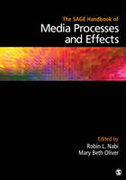
The study of media effects is one of the most central to the discipline of communication and encompasses a vast array of theoretical perspectives, methodological tools, and application to important social contexts. In light of this importance--as well as the rapid changes in the media environment that have occurred during the past 20 years--this Handbook of media effects theorizing and research explores where media effects research has been over the past several decades, and, equally important, where it would be most fruitful to go in the years ahead. In addition to providing a comprehensive framework for those interested in media effects, the Handbook also emphasizes the changing nature of the media landscape. Thus, new technologies not only provide new venues for research, but they also represent challenges to many existing media effects theories (that were formulated prior to the widespread adoption of the Internet). The contemporary diversity of the field and its research is seen in chapters addressing sociological, cultural, and organizational approaches and in chapterson specific approaches, domains, and context-related effects. Throughout the Handbook and within each chapter, authors address the following issues: (1) historical context on theory development//area of study; (2) theory explication and theoretical developments through to the present; (3) typical method of study//research approach//moderators; (4) conceptualization of the audience; (5) the impact of new media environments; (6) criticismsntroversies; and (7) directions for future research. INDICE: PART I. CONCEPTUAL AND METHODOLOGICAL ISSUES / A Retrospective andProspective Look at Media Effects / Conceptualizing the Audience / Quantitative Methods and Causal Inference in Media Effects Research / Qualitative Methods / PART II. SOCIETY, POLITICS, AND CULTURE / Cultivation Analysis and Media Effects / Framing and Agenda Setting / The Influence of Presumed Media Influence: Origins and Implications of the Third-Person / News and Poliltics / Media Effects and Cultural Studies: A Contentious Relationship / PART III. MESSAGE SELECTION AND PROCESSING / Uses and Gratifications: An Evolving Perspective of Media Effects / Entertainment / Current Research in Media Priming / The LimitedCapacity Model of Motivated Mediated Message Processing / Emotion and Media Effects / Mediated Relationships and Media Effects: Parasocial Interaction and Identification / Individual Differences in Media Effects / Media Use and the Social Environment / PART IV. PERSUASION AND LEARNING / Theories of Persuasion / Social Cognitive Theory and Media Effects / Emerging Issue in Advertising Research / Media Effects and Population Health / Educational Television / Media Literacy / PART V. CONTENT AND AUDIENCES / Violent Media Effects / Racial//Ethnic Stereotyping and the Media / Media and the Body / Media and Sexuality / Perceptions of Media Realism and Reality TV / The Effects of Viewing Televised Sports / Digital Games / Children and Adolescents: Distinctive Audiences of Media Content / PART VI. MEDIUM ISSUES / Diffusion of Innovations: Theoretical Extensions / Displacement Effects / Medium Theory: An Alternative to the Dominant Paradigm of Media Effects / The Evolution of Media System Dependency Theory / Media Effects 2.0: Social and Psychological Effects of Communication Technologies / The Study of Media Effects in the Era of Internet Communication
- ISBN: 978-1-4129-5996-4
- Editorial: Sage Publications
- Encuadernacion: Cartoné
- Páginas: 680
- Fecha Publicación: 01/11/2009
- Nº Volúmenes: 1
- Idioma: Inglés
